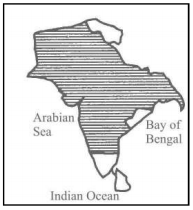(a) Bactria
(b) Scythia
(c) Zedrasia
(d) Aria
Ancient History
Which one of the following was initially the most powerful city state of India in the 6th century B.C. ?
(a) Gandhar
(b) Kamboj
(c) Kashi
(d) Magadh
The following persons came to India at one time or another:
1. Fa-Hien
2. I-Tsing
3. Megasthanese
4. Hieun-Tsang
The correct chronological sequence of their visits is:
(a) 3, 1, 2, 4
(b) 3, 1, 4, 2
(c) 1, 3, 2, 4
(d) 1, 3, 4, 2
From the third century AD when the Hun invasion ended the Roman Empire, the Indian merchants relied more and more on the:
(a) African trade
(b) West-European trade
(c) South-East Asian trade
(d) Middle-Eastern trade
The given map relates to :

(a) Kanishka at the time of his death.
(b) Samudragupta after the close of his South Indiancampaign.
(c) Ashoka towards close of his reign.
(d) Empire of Thaneswar on the eve of Harsha’s accession.
The concept of Eight fold path forms the theme of:
(a) Dipavamsa
(b) Divyavadana
(c) Mahaparinibban
(d) Dharma Chakara Pravartana Sutta
Which one of the following ancient Indian records is the earliest royal order to preserve food-grains to be utilised during the crises in the country?
(a) Sohgaura Copper-plate
(b) Rummindei Pillar-edict of Ashoka
(c) Prayaga-prasasti
(d) Mehrauli Pillar inscription of Chandra
Which of the following pairs are correctly matched?
1. Lothal : Ancient dockyard
2. Sarnath : First Sermon of Buddha
3. Rajgir : Lion capital of Ashoka
4. Nalanda : Great seat of Buddhist learning
Select the correct answer using the codes given below:
Codes:
(a) 1, 2, 3 and 4
(b) 3 and 4
(c) 1, 2 and 4
(d) 1 and 2
Assertion (A) and Reason (R) Question
Assertion (A): According to Ashoka’s edicts social harmony among the people was more important than religious devotion.
Reason (R): He spread ideas of equity instead of promotion of religion.
(a) Both A and R are true but R is the correct explanation of A
(b) Both A and R are true but R is not a correct explanation of A
(c) A is true but R is false
(d) A is false but R is true
What is the correct chronological order in which the following appeared in India?
1. Gold coins
2. Punch marked silver coins
3. Iron plough
4. Urban culture
Select the correct answer using the codes given below:
(a) 3, 4, 1, 2
(b) 3, 4, 2, 1
(c) 4, 3, 1, 2
(d) 4, 3, 2, 1
